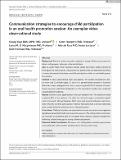Files in this item
Communication strategies to encourage child participation in an oral health promotion session : an exemplar video observational study
Item metadata
| dc.contributor.author | Yuan, Siyang | |
| dc.contributor.author | Humphris, Gerald Michael | |
| dc.contributor.author | Macpherson, Lorna M. D. | |
| dc.contributor.author | Ross, Alastair | |
| dc.contributor.author | Freeman, Ruth | |
| dc.date.accessioned | 2021-02-22T16:30:14Z | |
| dc.date.available | 2021-02-22T16:30:14Z | |
| dc.date.issued | 2021-04 | |
| dc.identifier | 272825598 | |
| dc.identifier | 16e8effc-95f4-4339-8fe3-47463156bb62 | |
| dc.identifier | 85100961159 | |
| dc.identifier | 000619617600001 | |
| dc.identifier.citation | Yuan , S , Humphris , G M , Macpherson , L M D , Ross , A & Freeman , R 2021 , ' Communication strategies to encourage child participation in an oral health promotion session : an exemplar video observational study ' , Health Expectations , vol. 24 , no. 2 , pp. 700-708 . https://doi.org/10.1111/hex.13219 | en |
| dc.identifier.issn | 1369-6513 | |
| dc.identifier.other | ORCID: /0000-0002-4601-8834/work/89627965 | |
| dc.identifier.uri | https://hdl.handle.net/10023/21479 | |
| dc.description | We would like to acknowledge the funding from the Scottish Government for the Childsmile Programme. | en |
| dc.description.abstract | Background : The oral health promotion sessions for young children and parents in a clinical setting pose challenges to the dental team. Aim : To apply PaeD‐TrICS (Paediatric dental triadic interaction coding scheme) to investigate the interaction of child, parent and dental nurse and determine the effect of nurse and parental behaviours on child participation within an oral health promotion session. Method : A video observational study was applied. The sample consisted of a dental nurse and 22 children aged 2‐5 years in a general dental practice in Scotland. Behaviours were catalogued with time stamps using PaeD‐TrICS. Analysis of behavioural sequences with child participation as the dependent variable was conducted using multilevel modelling. Results : Children varied significantly in their participation rate. The statistical model explained 28% of the variance. The older the child and longer consultations significantly increased child participation. Both nurse and parental behaviour had immediate influence on child participation. Parental facilitation had a strong moderating effect on the influence of the nurse on child participation. Conclusions : Child participation was dependent on nurse and parent encouragement signalling an important triadic communication process. The coding scheme and analysis illustrates an important tool to investigate these advisory sessions designed for delivering tailored messages to young children and parents. Patient or Public Contribution : The dental staff, child patients and their parents were involved closely in the conduct and procedures of the present study. | |
| dc.format.extent | 9 | |
| dc.format.extent | 334643 | |
| dc.language.iso | eng | |
| dc.relation.ispartof | Health Expectations | en |
| dc.subject | Child participation | en |
| dc.subject | Triadic communication | en |
| dc.subject | Communication behaviour | en |
| dc.subject | Oral health promotion | en |
| dc.subject | Video observation | en |
| dc.subject | RJ Pediatrics | en |
| dc.subject | RK Dentistry | en |
| dc.subject | 3rd-DAS | en |
| dc.subject.lcc | RJ | en |
| dc.subject.lcc | RK | en |
| dc.title | Communication strategies to encourage child participation in an oral health promotion session : an exemplar video observational study | en |
| dc.type | Journal article | en |
| dc.contributor.institution | University of St Andrews. Sir James Mackenzie Institute for Early Diagnosis | en |
| dc.contributor.institution | University of St Andrews. Population and Behavioural Science Division | en |
| dc.contributor.institution | University of St Andrews. WHO Collaborating Centre for International Child & Adolescent Health Policy | en |
| dc.contributor.institution | University of St Andrews. Health Psychology | en |
| dc.contributor.institution | University of St Andrews. St Andrews Sustainability Institute | en |
| dc.contributor.institution | University of St Andrews. School of Medicine | en |
| dc.identifier.doi | https://doi.org/10.1111/hex.13219 | |
| dc.description.status | Peer reviewed | en |
This item appears in the following Collection(s)
Items in the St Andrews Research Repository are protected by copyright, with all rights reserved, unless otherwise indicated.

